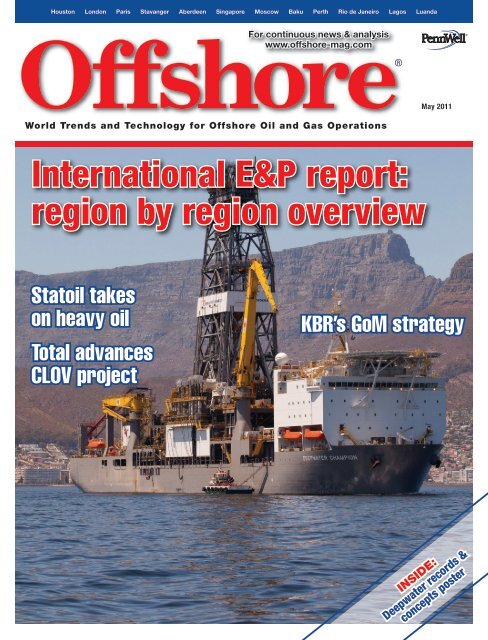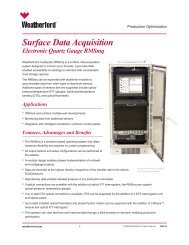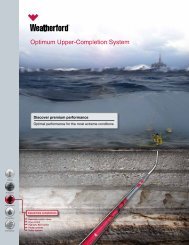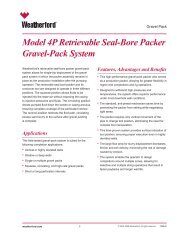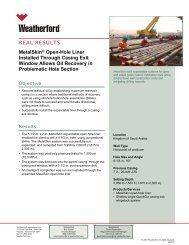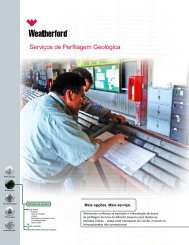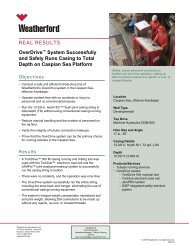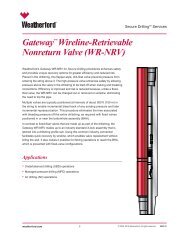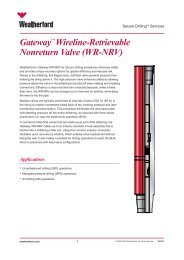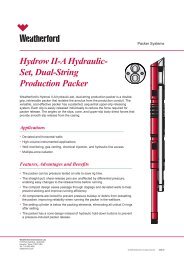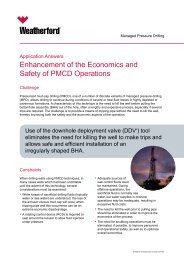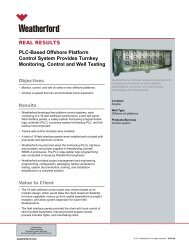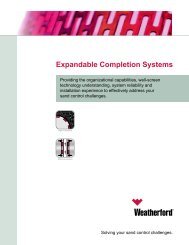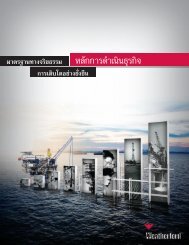First Automated MPD in Mexico GoM - Weatherford International
First Automated MPD in Mexico GoM - Weatherford International
First Automated MPD in Mexico GoM - Weatherford International
Create successful ePaper yourself
Turn your PDF publications into a flip-book with our unique Google optimized e-Paper software.
Houston London Paris Stavanger Aberdeen S<strong>in</strong>gapore Moscow Baku Perth Rio de Janeiro Lagos LuandaFor cont<strong>in</strong>uous news & analysiswww.offshore-mag.comWorld Trends and Technology for Offshore Oil and Gas OperationsMay 2011<strong>International</strong> E&P report:region by region overviewStatoil takeson heavy oilTotal advancesCLOV projectKBR’s <strong>GoM</strong> strategyINSIDE:Deepwater records &concepts poster
D R I L L I N G & C O M P L E T I O N<strong>First</strong> automated <strong>MPD</strong><strong>in</strong> <strong>Mexico</strong> <strong>GoM</strong> cuts drill<strong>in</strong>g daysLuis GiralGerman Castiblanco<strong>Weatherford</strong> <strong>International</strong> Ltd.Risk, safety enhancements improve performance <strong>in</strong> carbonate drill<strong>in</strong>gA footpr<strong>in</strong>t of only 5 x 5 m was required forthe deck components of the automatic <strong>MPD</strong>package, <strong>in</strong>clud<strong>in</strong>g choke manifold, Microfluxcontrol system, and the separator added tohandle the anticipated gas <strong>in</strong>fluxes.Drill<strong>in</strong>g <strong>in</strong> the fractured carbonate formationsof the Gulf of <strong>Mexico</strong> typicallyposes many challenges to riskmanagement, safety, and drill<strong>in</strong>g efficiency.Significant nonproductivetime(NPT) is generated by lost circulationand/or gas <strong>in</strong>fluxes <strong>in</strong> the high-pressureformations, and a host of related problems.In some cases, the conditions are so overwhelm<strong>in</strong>gthat the hole is undrillable us<strong>in</strong>gconventional means and must be abandoned.These difficult issues have been successfullyaddressed <strong>in</strong> the first use of automated managedpressure drill<strong>in</strong>g (<strong>MPD</strong>) <strong>in</strong> the <strong>GoM</strong>. Bymeasur<strong>in</strong>g and manag<strong>in</strong>g bottomhole wellborepressures <strong>in</strong> real time, the <strong>MPD</strong> system enableda proactive response to downhole <strong>in</strong>fluxesand losses that greatly reduced hole problemsand improved safety. The performanceenhancements resulted <strong>in</strong> successfully drill<strong>in</strong>gthe designed hole size to target depth 12 daysfaster than the best offset.Land and offshore drill<strong>in</strong>g operationsalong <strong>Mexico</strong>’s Tabasco coast face majordifficulties posed by variations <strong>in</strong> pore pressuresand fracture gradients, depleted reservoirs,and highly fractured carbonates.The fractured carbonate formations presentnegative drill<strong>in</strong>g w<strong>in</strong>dows where pore pressureand fracture pressure overlap, result<strong>in</strong>g<strong>in</strong> entire sections experienc<strong>in</strong>g completecirculation losses.The offshore development well selectedfor application of <strong>Weatherford</strong>’s <strong>MPD</strong>monitor<strong>in</strong>g, analysis, and managementsystem is about 27 m (89 ft) of water. Offsetwells had experienced considerablecost-<strong>in</strong>creas<strong>in</strong>g NPT due to a variety ofoperational problems, <strong>in</strong>clud<strong>in</strong>g lost circulationand gas <strong>in</strong>fluxes (sometimessimultaneously), difficulty identify<strong>in</strong>gwashout and balloon<strong>in</strong>g events, differentialstick<strong>in</strong>g, the presence of hydrogensulfide (H 2S) gas, low penetration rates, andformation damage.<strong>MPD</strong> objectivesThe primary objective of us<strong>in</strong>g the automated<strong>MPD</strong> system was to reach the target depthwith the planned 8½-<strong>in</strong>. hole while <strong>in</strong>curr<strong>in</strong>gas little NPT as possible through the reservoirsection. The operational strategy was based onthree key <strong>MPD</strong> capabilities: us<strong>in</strong>g a lower mudweight, real-time monitor<strong>in</strong>g of small variations<strong>in</strong> bottomhole pressure, and proactive managementof those pressure changes to preventthem from escalat<strong>in</strong>g <strong>in</strong>to well control events.Mud weight was reduced to enhance therate of penetration (ROP). Conventional drill<strong>in</strong>goperations typically use a heavier mud weightas a necessary safety marg<strong>in</strong> because they dependon estimates of pore pressure rather thanactual data acquired while drill<strong>in</strong>g. Real-timemonitor<strong>in</strong>g and management of losses and <strong>in</strong>fluxesfacilitate the use of a mud weight closerto optimal weight without compromis<strong>in</strong>g safety.A lower-density mud also allows for easiercontrol or elim<strong>in</strong>ation of fluid losses when enter<strong>in</strong>gweak formations. And when drill<strong>in</strong>g <strong>in</strong> thereservoir, a lighter mud reduces sk<strong>in</strong> damagethat can limit the well’s production potential.Improved drill<strong>in</strong>g operationsResults from the <strong>MPD</strong> well compared to twooffset wells clearly show the success of the application.With <strong>MPD</strong>, the 8½-<strong>in</strong>. hole sectionRepr<strong>in</strong>ted with revisions to format, from the May 2011 edition of OFFSHORECopyright 2011 by PennWell Corporationwas drilled <strong>in</strong> 26 days versus 38 and 59 daysfor the offsets, sav<strong>in</strong>g 12 and 33 days respectively.ROP averaged 5-6 m/hr while the offsetsmanaged only 1-2 m/hr. The <strong>MPD</strong> well also requiredfewer bits (three) that the offsets whichrequired six and eight bits.<strong>MPD</strong> operations began with a lowerdensitymud than the offsets and averageda lower weight throughout the drill<strong>in</strong>g. The<strong>in</strong>verse emulsion mud weight ranged from1.58 to 1.96 gr/cc <strong>in</strong> the first offset well andfrom 1.05 to 1.96 gr/cc <strong>in</strong> the second. In the<strong>MPD</strong> well, it averaged 1.49 to 1.68 gr/cc.Kick and loss mitigation benefited fromreal-time detection and management of verysmall volume <strong>in</strong>fluxes.Operational highlightsThe <strong>MPD</strong> operation began with a pressuretest of all of the <strong>MPD</strong> surface equipment. Thebottomhole assembly (BHA) – consist<strong>in</strong>g ofan 8½-<strong>in</strong>. polycrystall<strong>in</strong>e diamond compactdrill bit, 6 ¾-<strong>in</strong>. x 8 ½-<strong>in</strong>. stabilizers, 6½-<strong>in</strong>. drillcollars, a 5-<strong>in</strong>. heavyweight drill pipe and a 5-<strong>in</strong>.drill pipe – was lowered <strong>in</strong>to the well.Once the assembly was 50 m above theshale, the automated system was tested <strong>in</strong>sidethe cas<strong>in</strong>g before lower<strong>in</strong>g the accessories.The objective of this procedure was to calibratethe response of the system to <strong>in</strong>fluxes,losses, equivalent circulat<strong>in</strong>g density (ECD)control, swabb<strong>in</strong>g, and surg<strong>in</strong>g. The cas<strong>in</strong>gshoe was drilled out when the calibration wascomplete.Drill<strong>in</strong>g of the 8½-<strong>in</strong>. section began at4,375 m with a mud density of 1.65 gr/ccand a flow rate of 330 gpm, for an ECD of1.70 gr/cc. The mud density selected forthe <strong>MPD</strong> operation was 0.15 gr/cc lowerthan the conventional figure of 1.80 gr/cc.The automated system began <strong>in</strong> standardmode, with the chokes fully open,monitor<strong>in</strong>g the entrance and exit flow torespond to any unexpected event. Essentially,the strategy was to wait until thewell “spoke” before mak<strong>in</strong>g decisions <strong>in</strong>accordance with the density and bottomholecirculat<strong>in</strong>g pressure (BHCP).One of the events that demonstratedthe significant benefit of the automatedsystem was the early identification of a
D R I L L I N G & C O M P L E T I O NThe system identifies a gas <strong>in</strong>flux while drill<strong>in</strong>g at 4,426 m. Because of the earlykick detection capabilities of the system, the pit ga<strong>in</strong> was only 1.5 bbl.very small <strong>in</strong>flux. At a measured depth of about 4,400 m, the automatedsystem detected an <strong>in</strong>flux of only 1.5 bbl. The <strong>in</strong>flux wascontrolled <strong>in</strong> less than 2 m<strong>in</strong>.The Microflux system detected an <strong>in</strong>crease <strong>in</strong> outflow comparedto <strong>in</strong>flow. Based on <strong>in</strong>ternal algorithms, the system <strong>in</strong>dicated to the<strong>MPD</strong> choke to adjust automatically. The application of back pressureequalized the <strong>in</strong>flow and outflow.The <strong>in</strong>flux that had been <strong>in</strong>corporated <strong>in</strong>to the mud system was thencirculated out by apply<strong>in</strong>g 650 psi back pressure. Drill<strong>in</strong>g cont<strong>in</strong>ued whileback pressure was <strong>in</strong>creased to 750 psi, which addressed the safety factorrequired by the operat<strong>in</strong>g company.This response contrasts with the <strong>in</strong>evitable NPT result<strong>in</strong>g fromconventional well control procedures and maneuvers that are the onlyavailable response when a high-pressure formation is conventionallydrilled.Conventionally, an <strong>in</strong>flux is typically confirmed after a ga<strong>in</strong> of manybarrels (typically 10 to 20 bbl). With the constant bottomhole pressuremethod of <strong>MPD</strong>, downhole <strong>in</strong>fluxes are detected typically at afew barrels and managed quickly before they escalate <strong>in</strong>to a well controlevent.After evaluat<strong>in</strong>g the situation, it was determ<strong>in</strong>ed that the optionswere to cont<strong>in</strong>ue drill<strong>in</strong>g with this back pressure or to <strong>in</strong>crease thedrill<strong>in</strong>g fluid density to reduce it. Consider<strong>in</strong>g the risk of f<strong>in</strong>d<strong>in</strong>g a new<strong>in</strong>terval with higher pore pressure, it was decided to <strong>in</strong>crease the mudweight from 1.65 gr/cc to 1.68 gr/cc. Back pressure was reduced by500 psi to cont<strong>in</strong>ue drill<strong>in</strong>g.The <strong>MPD</strong> connection was made at 4,435 m MD to keep the bottomholepressure constant and to replace the friction losses withback pressure. Drill<strong>in</strong>g cont<strong>in</strong>ued with a density of 1.68 gr/cc and ata depth of 4,480 m MD, total circulation losses were detected.In the lower part of the section, the outflow curve moved to theleft, <strong>in</strong>dicat<strong>in</strong>g total losses. The behavior of the system once gas wasdetected on the surface is seen <strong>in</strong> the accompany<strong>in</strong>g illustration. Anerroneous read<strong>in</strong>g was seen <strong>in</strong> the exit flow, which is typical of gaspass<strong>in</strong>g through the system. The system generated an alert, signify<strong>in</strong>gthe presence of gas on the surface.Both monitor<strong>in</strong>g and management capabilities are based on thebehavior of the <strong>in</strong>compressible drill<strong>in</strong>g fluid conta<strong>in</strong>ed with<strong>in</strong> a pressurizedclosed-loop system. In this environment, a change<strong>in</strong> bottomhole pressure due to an <strong>in</strong>flux or loss is detected<strong>in</strong> seconds by surface <strong>in</strong>struments monitor<strong>in</strong>g the flow andpressure.Conversely, a change <strong>in</strong> annular pressure (back pressure)effected by clos<strong>in</strong>g an <strong>MPD</strong> choke or add<strong>in</strong>g fluid via a pumpis quickly felt at the bottom of the hole. Small, fast changes<strong>in</strong> ECD are made easily without chang<strong>in</strong>g the mud system ordelay<strong>in</strong>g drill<strong>in</strong>g.In automatic mode, the <strong>MPD</strong> systems detects rapid fluctuations<strong>in</strong> downhole pressure, algorithmically processesthem and immediately translates the data <strong>in</strong>to changes <strong>in</strong> annularback pressure necessary to ma<strong>in</strong>ta<strong>in</strong> a balance with<strong>in</strong>the drill<strong>in</strong>g w<strong>in</strong>dow. In this manner, the <strong>MPD</strong> system managesbottomhole pressure even when the pumps are off whilemak<strong>in</strong>g pipe connections.<strong>MPD</strong> technology also reduces the risk of hazardous gas production.Gas <strong>in</strong>fluxes are limited by <strong>MPD</strong> procedures, along withthe risk of sour gas release. Any gas gett<strong>in</strong>g <strong>in</strong>to the system issmall and easily circulated <strong>in</strong> a controlled manner. The closedloopsystem also conta<strong>in</strong>s the gas and directs it away from therig floor.The <strong>MPD</strong> equipment spread chosen for the <strong>GoM</strong> wellconsisted of several relatively common rig equipment components<strong>in</strong>tegrated by the Microflux control system.A 13 5 ⁄8-<strong>in</strong>. rotat<strong>in</strong>g control device (RCD) with a double seal<strong>in</strong>g elementwas specified for the well. An RCD is the def<strong>in</strong><strong>in</strong>g componentof an <strong>MPD</strong> operation. Installed on top of the BOP <strong>in</strong> land or offshoresurface applications, the RCD effectively encloses the circulation loopwith an elastomeric seal that closes the annulus and redirects the mudsystem returns. This creates a pressurized closed-loop system that ishighly sensitive to pressure changes <strong>in</strong>itiated either downhole or at thesurface.With<strong>in</strong> this closed-loop system, pressure is managed accuratelythrough application of annular back pressure.On the <strong>GoM</strong> well, this back pressure was provided two ways – anautomated <strong>MPD</strong> choke system located downstream from the RCD andahead of the mud handl<strong>in</strong>g system, and an auxiliary annular pump (<strong>in</strong>this case achieved by connect<strong>in</strong>g the cement<strong>in</strong>g pump already on theplatform).The choke package also <strong>in</strong>cludes meter<strong>in</strong>g to measure mass flowand pressure. This data helps <strong>in</strong>form the control system, which appliesproprietary algorithms to monitor, analyze, and manage downholepressure.The data is used for conventional well control as well as manual andautomatic <strong>MPD</strong> applications. Automation speeds the time from <strong>in</strong>formationreceipt to action be<strong>in</strong>g taken. In difficult wellbore environments,this enhances the ability to proactively manage <strong>in</strong>fluxes and losses beforethey become well control events.The flowl<strong>in</strong>e used <strong>in</strong> the <strong>GoM</strong> application was carbon steel pip<strong>in</strong>gwith 4-<strong>in</strong>. connections and 5,000-psi maximum allowable work<strong>in</strong>gpressure. It was tested at the maximum static work<strong>in</strong>g pressure ofthe rotat<strong>in</strong>g head.The particular formation characteristics and the confirmed presenceof large volumes of gas <strong>in</strong> kick-loss situations necessitateduse of a higher-capacity fluid separator <strong>in</strong>dependent from the drill<strong>in</strong>gequipment separator. A vertical, two-phase atmospheric separatorwas used to manage possible <strong>in</strong>fluxes. The separator had sufficientcapacity and residence time to ensure the complete releaseof gases return<strong>in</strong>g from the well. The objective was to m<strong>in</strong>imizethe possibility of these gases be<strong>in</strong>g released <strong>in</strong>to the shale shakeror mud tanks. •


